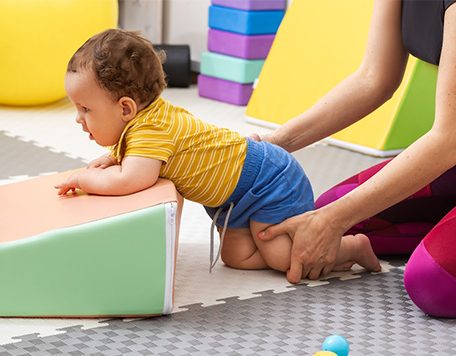Cuevas Medek Exercises (CME) and Dynamic Movement Intervention (DMI) are revolutionary ways to enhance motor function in kids with movement disorders. These two therapies promote motor control and neurostimulation and improve functional movement among kids with conditions like cerebral palsy. Though each therapy takes a different approach, they share common goals and principles.
What is Dynamic Movement Intervention (DMI)?
Dynamic Movement Intervention (DMI) is a specialized treatment method for children with movement disorders. DMI involves leading children through systematic movement to stimulate particular neural pathways, facilitating enhanced motor control, balance, and coordination. DMI is used mainly for children with cerebral palsy and other similar neurological conditions but has general applications for a variety of developmental issues.
The main components of DMI are:
Targeted movements: Stimulate the nervous system and activate muscle groups.
Hands-on guidance: Trained therapists use precise positioning to facilitate better movement patterns.
Repetitive exercises: Designed to promote neuroplasticity, these exercises allow the brain to form new neural connections for improved motor function.
Postural alignment and control: It helps the child achieve more functional movements, such as walking, sitting, or standing independently.
DMI aims to assist children in gaining more independence in their physical activity through increased muscle tone, motor control, and joint mobility via dynamic, structured interventions.
What is Cuevas Medek Exercises (CME)?
Cuevas Medek Exercises (CME) is a treatment technique used to assist children with neuromotor disorders in enhancing their functional motor skills. Developed by Dr. Ramon Cuevas, CME emphasizes the application of dynamic, gravity-supported exercises that activate the nervous system to improve coordination, balance, and muscle strength.
Key characteristics of CME are:
- High-intensity exercises with gravity assistance stimulate reflexes and involvement of the body in intricate motor patterns.
- Progressive exercises with gradual increases in difficulty stimulate the child’s neuromuscular system and encourage motor development.
- Therapist-supported movements that support the child’s body in particular positions assist in developing improved posture and balance.
- Functional motor development, such as sitting, standing, and walking, focuses on enhancing daily living skills.
CME emphasizes the development of the neural connections that govern movement, stimulating motor development through repetition and specific exercises that activate the child’s sensory and motor systems.
Similarities between DMI and CME
- Neuroplasticity: DMI and CME are focused on stimulating the nervous system to enhance motor control by promoting neuroplasticity. Repetitive movements in both therapies stimulate the brain’s capacity for creating new connections that improve motor function.
- Therapist-Guided Intervention: Both therapies use hands-on intervention by experienced therapists. The therapist gives direct assistance while doing exercises, ensuring the child moves correctly and safely and providing feedback to assist them in becoming better.
- Repetition and Motor Learning: Both therapies use repetition to strengthen motor skills. By practicing specific movements repeatedly, children enhance muscle coordination and have greater control over their movements.
- Functional Movement: The end goal of both therapies is functional movement improvement. Whether walking, sitting, or carrying out daily activities, both DMI and CME aim to make children independent in their physical functions.
- Customization: Both DMI and CME are very customized therapies. The therapist customizes the exercises according to the child’s needs, varying the intensity and difficulty as per their present capabilities and improvements.
Significant Differences Between DMI and CME
- Area of Focus in Exercises: DMI tends to emphasize postural alignment and the correction of the activation patterns of the muscles to enhance motor function, especially in children with cerebral palsy. CME employs a broader scope of dynamic exercises emphasizing reflex integration, balance, and overall motor development.
- Exercise Progression: CME tends to have a systematic, step-by-step exercise progression that advances in complexity, from simple reflexive movements to more complex motor tasks. DMI, though progressive, tends to be more targeted to specific functional movement and posture corrections of abnormal movement patterns.
- Target Conditions: Although both therapies can help children with neurological conditions, DMI is particularly effective in children with cerebral palsy and other motor impairments. CME is applied more broadly for a variety of neuromotor and developmental disorders to enable children to move through several milestones.
- Intensity and Approach: CME is more likely to consist of more intense activities with gravity to aid in movement, whereas DMI concentrates on controlled positioning of the posture and organized, specific movements. The intensity and mode of engagement may differ between the two treatments.
Conclusion
Dynamic Movement Intervention (DMI) and Cuevas Medek Exercises (CME) are robust treatments for children with movement disorders aimed at increasing motor control, improving posture, and enhancing functional independence. Even though each treatment employs a different methodology, the two share the same overarching aim of provoking neuroplasticity and increasing motor function overall via repetition of the therapist-led exercise.DMI (Dynamic Movement Intervention) is based on the philosophy of CME (Cuevas Medek Exercise), a form of therapy created to facilitate the development of children with special needs. The DMI founders were initially trained as CME therapists.



1 Comment
national pharmacies
Terrific post however I was wanting to know if you could write a litte more on this subject? I’d be very grateful if you could elaborate a little bit more. Appreciate it!